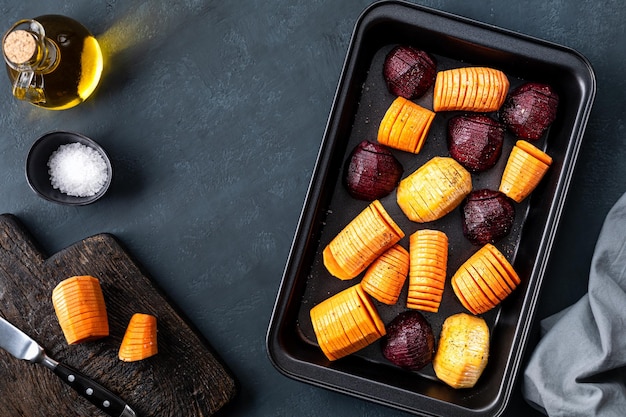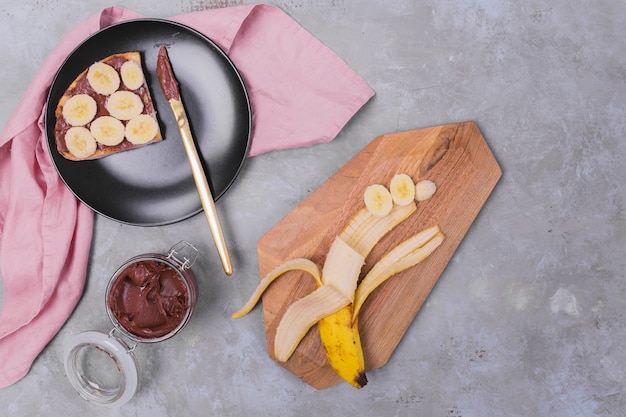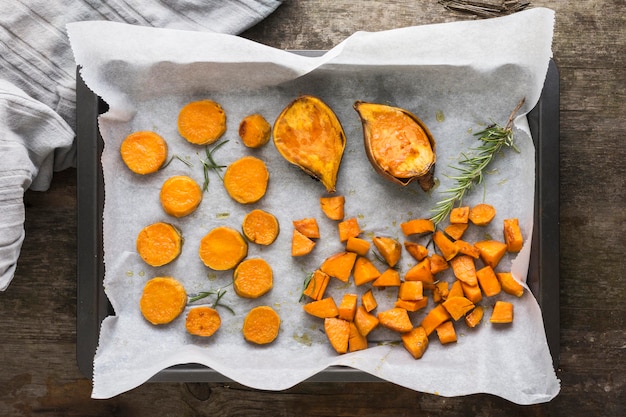You know that feeling when you’re craving a warm, comforting sweet potato, but you’re not sure how to bake them to get that perfect, fluffy texture? You don’t want them mushy, but you also don’t want them to be rock-hard. I’ve been there, and believe me, it’s a baking dilemma!
Over the years, I've experimented with countless sweet potato baking methods and temperatures, and let me tell you, there’s a sweet spot (pun intended!) for every preference. Today, I’m going to share all the secrets I’ve learned about baking the perfect sweet potato, from the basic techniques to a plethora of flavor combinations. Grab a cuppa, settle in, and let’s embark on this delicious journey together.
(Part 1) The Basics of baking sweet potatoes

1.1 Sweet Potato vs. Yam: What's the Difference?
Let’s get one thing straight – those “yams” you see in the grocery store? They’re not actually yams. They’re a variety of sweet potato with a drier texture and a more intense, almost candy-like flavour. While both regular sweet potatoes and these "yams" are delicious and versatile, knowing the differences can help you choose the best one for your recipe. I personally prefer the classic sweet potato, but those "yams" are a great alternative for certain dishes.
1.2 The Importance of Baking Temperature
The key to baking a sweet potato that’s both fluffy and flavorful is to bake it low and slow. Think of it like a slow roast – it allows the heat to penetrate the sweet potato evenly and develop that melt-in-your-mouth texture we all adore.
Generally, a temperature between 350°F (175°C) and 400°F (200°C) is perfect. If you crank up the heat too much, you risk burning the outside before the inside is cooked through, resulting in a bitter, dry sweet potato – a real culinary tragedy!
1.3 Baking Time and Size
The size of your sweet potatoes is a crucial factor. Smaller ones will bake faster, while larger ones will need a bit more time. A good rule of thumb is to expect around 45-60 minutes for medium-sized sweet potatoes, but always check them earlier by sticking a fork in the center. If it goes in easily and comes out clean, they’re ready to go.
(Part 2) Baking Methods and Tips

Now that we’ve covered the basics, let's dive into the different ways you can bake your sweet potatoes and how to ensure perfection.
2.1 The Classic Method: Wrapped in Foil
This is my go-to method for achieving the most tender and moist sweet potatoes. It’s simple, reliable, and always delivers delicious results.
You simply wrap your sweet potatoes tightly in foil, creating a sealed package, and then place them in the oven. The foil traps the steam, which helps to cook the sweet potatoes from the inside out, resulting in a beautifully soft and moist texture.
2.1.1 Tips for Foil-Wrapped Baking
Prick a few holes in the foil: This allows some steam to escape, preventing the sweet potatoes from steaming too much and becoming mushy.
Use heavy-duty foil: Avoid those flimsy ones that might tear.
Don't overcrowd the baking sheet: Give those sweet potatoes some space to breathe!
2.2 Unwrapped Baking
Some folks prefer to bake their sweet potatoes unwrapped. This method allows the sweet potato to caramelize slightly, creating a slightly sweeter and more intense flavour. However, it can also lead to drying out, so you need to keep a close eye on them.
2.2.1 Tips for Unwrapped Baking
Place a small amount of water in the bottom of your baking dish to prevent the sweet potatoes from drying out. Water, broth, or even a little bit of apple cider work great.
Flip them halfway through baking: This ensures even cooking.
2.3 Baking in a slow cooker
The slow cooker is a culinary lifesaver, especially for those who prefer a hands-off approach to baking. You simply toss the sweet potatoes into the slow cooker, set it on low, and let it work its magic.
2.3.1 Tips for Slow Cooker Baking
Add a little bit of liquid to the bottom of the slow cooker to keep the sweet potatoes moist. Water, broth, or even a little bit of apple cider work great.
Bake them on low for 6-8 hours, or on high for 3-4 hours.
Get creative! You can add other ingredients like onions, garlic, or spices for extra flavour.
2.4 Baking in the Microwave
You might be surprised, but the microwave can be a quick and efficient way to bake a sweet potato. It's ideal for a quick snack or when you’re short on time.
2.4.1 Tips for Microwave Baking
Prick the sweet potato several times with a fork to prevent it from exploding.
Bake for 5-7 minutes on high power, depending on the size of the sweet potato.
Turn it over halfway through cooking to ensure even cooking.
(Part 3) Sweet Potato Baking Temperature Table

Here’s a handy table that summarizes the ideal baking temperatures and times for different methods:
| Method | Temperature (°F) | Temperature (°C) | Time |
|---|---|---|---|
| Wrapped in Foil | 350-400 | 175-200 | 45-60 minutes (medium size) |
| Unwrapped | 400 | 200 | 45-60 minutes (medium size) |
| Slow Cooker | Low | Low | 6-8 hours |
| Microwave | High | High | 5-7 minutes |
(Part 4) Beyond the Basics: Adding Flavour
Now that we’ve mastered the basics, let’s talk about adding flavour! It’s time to unleash your culinary creativity and create delicious sweet potato masterpieces.
4.1 Spices
Sweet potatoes are a blank canvas for spices. They pair beautifully with a variety of flavours, adding warmth, complexity, and a touch of magic to your creations.
- Cinnamon: A classic for a reason! It adds a warm, comforting flavour that pairs perfectly with sweet potatoes.
- Nutmeg: A little goes a long way, but it brings a delicious, slightly earthy flavour that adds depth and complexity.
- Ginger: This adds a bit of heat and zing, making for a sweet and spicy combination that’s both exciting and satisfying.
- Cayenne Pepper: For those who like things spicy, a sprinkle of cayenne pepper adds a kick. Be careful not to overdo it – a little goes a long way!
- Allspice: This adds a beautiful complexity of flavour, with notes of cinnamon, nutmeg, and clove.
4.2 Sweeteners
Sweet potatoes are naturally sweet, but a touch of sweetener can enhance their natural sweetness and create a richer flavour.
- Honey: It adds a subtle sweetness and a lovely golden colour.
- Maple Syrup: A great alternative to honey, especially if you’re looking for a more pronounced flavour.
- Brown Sugar: A classic choice for a caramelized flavour.
4.3 Other Ingredients
There are tons of other things you can add to your sweet potatoes for extra flavour and texture.
- Salt and Pepper: A pinch of salt and pepper enhances the natural sweetness of the sweet potato, bringing out its flavour profile.
- Butter or Olive Oil: These add richness and creaminess, creating a luxurious texture.
- Chopped Nuts: Adds texture and nutty flavour. Try pecans, walnuts, or almonds.
- Dried Fruit: Adds sweetness and a burst of flavour. Raisins, cranberries, or apricots are great choices.
- Citrus Zest: Adds a bright and refreshing flavour. Lemon, lime, or orange zest work beautifully.
(Part 5) Sweet Potato Baking: A Personal Touch
Baking is an art form – it's about more than just following recipes. It's about putting your own personal touch on things and creating something unique that reflects your own taste and style.
I love experimenting with different flavours and textures, and I always encourage you to do the same. It's how we discover new culinary delights and find our own sweet potato baking bliss!
For instance, I love to add a dollop of Greek yogurt or a sprinkle of crumbled feta cheese to my baked sweet potatoes for a tangy and creamy flavour. And if I’m feeling fancy, I’ll whip up a quick salsa verde or a cilantro lime crema to top them off.
(Part 6) The Perfect Baked Sweet Potato: Signs of Doneness
Knowing when your sweet potato is perfectly baked is crucial to achieving the ideal texture and flavour. Here are a few fool-proof methods to ensure you don't overcook or undercook your sweet potato:
6.1 The Fork Test
This is the most reliable method. Stick a fork into the centre of the sweet potato. If it goes in easily and comes out clean, it’s done.
6.2 The Feel Test
Gently squeeze the sweet potato. If it feels soft and yielding, it’s ready.
6.3 The Colour Test
The skin of the sweet potato should be slightly wrinkled and the flesh should have a deep orange colour.
(Part 7) Serving Suggestions
Now, let's explore some delicious ways to serve your perfectly baked sweet potato. The possibilities are endless!
7.1 Sweet and Savoury
- Top with butter, cinnamon, and a drizzle of maple syrup for a warm and comforting treat.
- Mash with a fork and mix with some Greek yogurt, salt, and pepper for a simple and delicious side dish.
- Combine with black beans, corn, and a spicy chili sauce for a hearty and flavorful salad.
7.2 side dishes and Mains
- Serve alongside roasted chicken or fish for a satisfying and healthy meal.
- Use them as a base for a sweet potato shepherd’s pie.
- Add them to a chunky vegetable soup for extra sweetness and depth of flavour.
7.3 Sweet Treats
- Bake them into a sweet potato pie.
- Make a delicious and healthy sweet potato bread.
- Combine with other spices and nuts for a homemade sweet potato granola.
(Part 8) Storage and Leftovers
Let’s be honest, sometimes you end up with more baked sweet potatoes than you can eat in one sitting. Here’s how to store them so you can enjoy their deliciousness for days to come.
8.1 Refrigerator Storage
You can store baked sweet potatoes in the refrigerator for up to 3-4 days. Simply wrap them tightly in plastic wrap or foil to keep them from drying out.
8.2 Freezing
You can also freeze baked sweet potatoes for up to 3 months. Let them cool completely, then wrap them individually in plastic wrap and place them in a freezer-safe bag. When you’re ready to use them, thaw them in the refrigerator overnight.
FAQs
1. Can I bake sweet potatoes at a lower temperature?
Absolutely! But keep in mind that baking at a lower temperature will increase the cooking time. If you’re baking at 325°F (160°C), you might need to add another 15-20 minutes to the baking time.
2. What happens if I overbake sweet potatoes?
Overbaked sweet potatoes will be dry and hard. They might also have a burnt flavor. So it’s best to check them regularly and avoid overbaking.
3. Can I bake sweet potatoes with the skin on?
Yes, you can! In fact, baking with the skin on adds a bit of extra flavour and nutrients. Just be sure to scrub the sweet potatoes well before baking.
4. What can I use to substitute for foil?
You can use parchment paper instead of foil. Just make sure to fold it over the edges to create a sealed package.
5. What are some tips for making sweet potato mash?
To make a creamy and delicious sweet potato mash, use a potato ricer or a fork to mash the sweet potatoes. You can also add a bit of milk, cream, or butter to make it even creamier.
I hope this comprehensive guide has given you the knowledge and confidence to bake the perfect sweet potato every time. Remember, it’s all about finding what works best for you, so don’t be afraid to experiment. Happy baking!
Everyone is watching

Corn on the Cob: The Ultimate Guide to Perfectly Cooked Ears
Healthy MealsAh, corn on the cob. Just the name evokes images of sunny days, barbecues, and that sweet, juicy flavour that ...

Perfect Pork Roast Oven Cooking Time: A Guide to Delicious Results
Healthy MealsThere's something truly satisfying about a perfectly roasted pork. The aroma alone is enough to make your mout...

Ham Cooking Time: How Long to Bake, Smoke, or Boil a Delicious Ham
Healthy MealsAh, ham. It's a classic, isn't it? A real crowd-pleaser, especially around holidays. And when done right, it'...

Scallops: The Ultimate Guide to Perfect Cooking
Healthy MealsAh, scallops. Those delicate, sweet, and utterly delicious morsels of the sea. They hold a special place in my...

Spaghetti Squash: The Ultimate Guide to Cooking and Serving
Healthy MealsRemember that time you saw spaghetti squash at the supermarket, looking all bumpy and strange, and thought, "W...
